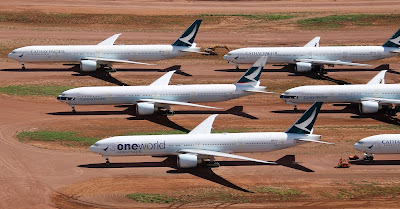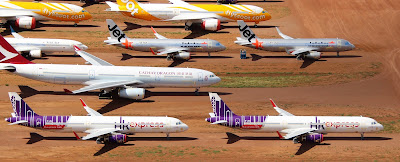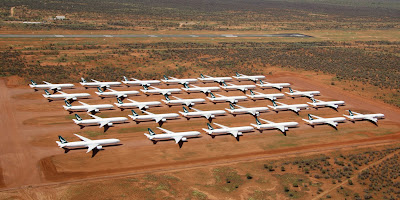.JPG) |
| BRITISH AIRWAYS BOEING 787-9 G-ZBKN (MSN 38630) |
On the 24th of June 1982, British Airways Flight 009, with a callsign of Speedbird 9, was performing a scheduled flight from London Heathrow (LHR/EGLL) to Auckland (AKL/NZAA), with stops in Delhi (DEL/VIDP), Kuala Lumpur (KUL/WMKK) and Perth (PER/YPPH).
During the Kuala Lumpur - Perth sector the aircraft flew into a cloud of volcanic ash thrown up by the eruption of Mount Galunggung around 110 miles (180 km) south-east of Jakarta, Indonesia, resulting in the failure of all four engines. Partly because the event occurred at night, obscuring the cloud, the reason for the failure was not immediately apparent to the crew or air traffic control.
Shortly after 13:40 UTC (20:40 Jakarta time) above the Indian Ocean, south of Java, the crew first noticed an unusual effect on the windscreen similar to St. Elmo's fire. Despite the weather radar showing clear skies, the crew switched on engine anti-ice and the passenger seat belt signs as a precaution.
As the flight progressed, smoke began to accumulate in the passenger cabin of the aircraft; it was first assumed to be cigarette smoke. However, it soon began to grow thicker and had an odour of sulphur. Passengers who had a view of the aircraft's engines through the window noted that they were unusually bright blue, with light shining forward through the fan blades and producing a stroboscopic effect.
Around 13:42 UTC (20:42 Jakarta time), the number-four Rolls-Royce RB211 engine began surging and soon flamed out. The flight crew immediately performed the engine shutdown drill, quickly cutting off fuel supply and arming the fire extinguishers. Less than a minute later, at 13:43 UTC (20:43 Jakarta time), engine two surged and flamed out. Within seconds, and almost simultaneously, engines one and three flamed out, prompting the flight engineer to exclaim, "I don't believe it—all four engines have failed!"
Without engine thrust, a 747-200 has a glide ratio of roughly 15:1, meaning it can glide forward 15 kilometres for every kilometre it drops. The flight crew quickly determined that the aircraft was capable of gliding for 23 minutes and covering 91 nautical miles (169 km) from its flight level of 37,000 feet (11,000 m).
At 13,500 feet (4,100 m), the crew was approaching the altitude at which they would have to turn over the ocean and attempt a risky ditching. Although the crew had guidelines for the water landing procedure, no one had ever tried it in a Boeing 747. As they performed the engine restart procedure, engine number four finally started, and at 13:56 UTC (20:56 Jakarta time), Moody used its power to reduce the rate of descent. Shortly thereafter, engine three restarted, allowing him to climb slowly. Shortly after that, engines one and two successfully restarted, as well. The crew subsequently requested and expedited an increase in altitude to clear the high mountains of Indonesia.
The aircraft landed safely in Jakarta.
The route was flown by the City of Edinburgh, a Boeing 747-236B registered as G-BDXH. The crew members of the accident segment had boarded the aircraft in Kuala Lumpur, while many of the passengers had been aboard since the flight began in London.
Aircraft Information:
Airline: British Airways
Code: BA/BAW
Aircraft: Boeing 747-236
Registration: G-BDXH
Serial Number: 21635
Engines: 4 x RR RB211-524D4
First Flew: 19/03/1979
Age at incident: 3.3 Years




.JPG)


.JPG)
.JPG)
.JPG)

.JPG)






.JPG)
.JPG)



